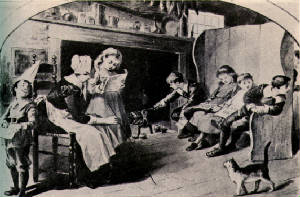|
In Colonial America,
Native Americans and European colonists had cultural traditions and values that were taught to their children. Basically, the family was the primary educator for children. For
European Puritans, the educational experience began as soon as possible, with parents bringing their infants to church for
baptism. Children participated in family prayer, worship, and Bible studies. Altenbaugh said, “The family taught literacy, transmitted religious morals,
and oversaw vocational training” (Altenbaugh, 26). But, education was not
limited to spiritual or vocational issues; parents discussed sexual conversations and taught children appropriate gender behaviors
(Altenbaugh, 27).
During the Colonial times,
a desire for a more institutionalized, formal education emerged. Schools began
to take over some of the families educational responsibilities. In addition,
the concept of free schooling started to become an issue. On the average, men
were more literate than females, but most females were able to read and write. Unfortunately,
they were viewed as intellectually inferior and morally vulnerable (Altenbaugh, 27).
For women, literacy was only important to facilitate religious training.
In the early 1800s, education
was viewed as a way to produce loyal Americans, and would ensure moral training and promote social stability. Children attended dame schools until age seven, and then moved on to grammar schools. After grammar schools, students went on to study at reading and writing schools in preparation for college.
|
 |

|
| Dame School in Colonial Times found at http://alumni.cc.gettysburg.edu/~s330558/schooling.html |
For more information on Colonial Education,
visit
Education in Colonial America
I shall
know why-When Time is over- And I have ceased to wonder why-
Christ will explain each separate anguish
In the fair schoolroom of the sky.
-Emily Dickinson
Found at http://alumni.cc.gettysburg.edu/~s330558/test.html
|

